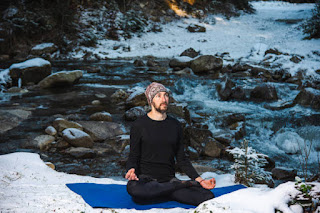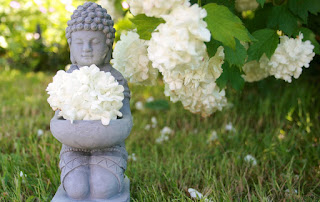The Practice of Santosha (Contentment) in Late Winter
The Practice of Santosha (Contentment) in Late Winter
As the final weeks of winter linger, many of us find ourselves yearning for the rejuvenation of spring. The gray skies, biting winds, and long nights can feel endless, often leaving us restless and discontented. Yet, it is precisely during this period that the practice of Santosha, or contentment, becomes an essential tool for cultivating peace and acceptance. Rooted in the Niyamas of Patanjali’s Yoga Sutras, Santosha invites us to find satisfaction in the present moment, regardless of our external circumstances. In this article, we’ll explore how to practice Santosha in late winter and align with the season’s unique energy.
Understanding Santosha in the Context of Winter
Winter is a time of stillness, a season that naturally encourages introspection and rest. But as winter drags on, many of us struggle to accept the slower pace, longing instead for the vibrancy of spring. Santosha is not about passive resignation but about active acceptance of life’s ebb and flow. By learning to embrace this period as an opportunity for reflection and growth, we cultivate a sense of peace that carries us through the season’s challenges.
The idea of contentment may seem simple, yet it requires a deep inner shift. In a culture that often glorifies constant productivity and achievement, practicing Santosha challenges us to slow down and be satisfied with where we are. This becomes even more important in late winter when our energy is low, and our patience might be wearing thin.
Embracing Stillness and Reflection
The natural world during late winter offers a powerful reminder of the importance of stillness. Trees stand bare, the earth rests beneath a blanket of frost, and animals continue to hibernate. This quietude can teach us to pause and reflect. Instead of fighting the stillness, we can learn to honor it, using it as a space to listen to our inner wisdom.
- Practical Tip: Dedicate 10-15 minutes daily to silent reflection. This can be a seated meditation or a quiet walk outdoors, observing the stillness of the landscape. Use this time to practice acceptance, noticing any restlessness without judgment.
Reflection Questions
- What do I notice in the stillness of late winter that I might overlook in busier times?
- How can I embrace the natural rhythm of the season and find contentment in quiet moments?
Practicing Gratitude for the Present Moment
Gratitude is a cornerstone of contentment. When we consciously focus on what we appreciate, even in the bleakness of late winter, we shift our mindset from longing to acceptance. A gratitude practice doesn’t have to be complex; it can be as simple as acknowledging the warmth of a cup of tea or the comfort of a soft blanket.
- Gratitude Journaling: Each day, write down three things you are grateful for. Focus on the simple joys unique to winter, like the beauty of a snow-covered landscape or the coziness of a warm home. By making this a daily habit, you can transform your perspective on the season.
Scientific Insights on Gratitude
Research has shown that practicing gratitude can improve mental health, boost immune function, and even increase overall life satisfaction. In late winter, when seasonal affective disorder (SAD) and general malaise are more common, cultivating gratitude can be a powerful antidote.
Mindful Practices to Cultivate Contentment
Incorporating mindfulness into daily activities is another powerful way to embody Santosha. By slowing down and bringing awareness to the present, we can find contentment even in mundane tasks. The simple act of savoring each moment, whether during a meal or a conversation, helps anchor us to the here and now.
Meditation for Acceptance
Try a guided meditation focused on acceptance and letting go of resistance. Visualize yourself embracing the season, feeling a sense of peace as you breathe into the present.
- Pranayama Practice: Engage in calming breathwork, such as Bhramari (humming bee breath) or gentle Ujjayibreathing. These practices soothe the nervous system and promote a feeling of contentment.
Mindful Living Tips
- While drinking your morning coffee or tea, take a few moments to savor the aroma and warmth. Practice being fully present and notice the sensations without rushing through the experience.
- When performing household chores, bring mindfulness to each movement. For example, as you wash dishes, feel the warmth of the water and notice the rhythm of your breath.
Adjusting Expectations and Letting Go
Winter often challenges our expectations. We may crave the warmth of spring or feel frustrated by the limited daylight. Practicing Santosha involves releasing these unmet expectations and embracing what is. This acceptance doesn’t mean we stop striving for better days, but rather that we find peace in the present while holding space for future possibilities.
- Letting Go Exercise: Write down your frustrations about winter, then reflect on how you might reframe these feelings to find contentment. For example, instead of seeing the darkness as a limitation, view it as a chance to rest and reset.
Common Misconceptions About Santosha
- Santosha is not about complacency. It doesn’t mean giving up on self-improvement or growth; it means finding balance and peace with what is while remaining open to positive change.
- Practicing Santosha does not eliminate discomfort but helps us accept it with greater ease.
Self-Compassion and Nourishment
Late winter can bring physical and emotional fatigue. It’s important to practice self-compassion, acknowledging that feeling unmotivated or weary is natural. Nourish yourself with warmth, whether through comforting foods, restorative yoga, or self-care rituals. Recognize that honoring your needs is a vital part of contentment.
Nourishing Winter Practices
- Restorative Yoga: Gentle poses like Child’s Pose (Balasana) and Reclined Butterfly (Supta Baddha Konasana) encourage deep relaxation and help release tension.
- Self-Care Rituals: Take warm baths infused with calming essential oils or savor a moment of stillness with a good book. These acts remind you that contentment is about appreciating the simple, nourishing experiences in life.
The Importance of Warmth and Comfort
Staying warm isn’t just a physical necessity; it also has a profound effect on our emotional well-being. Studies show that physical warmth can increase feelings of trust and connection, making it easier to practice contentment and compassion.
Yoga Practices for Santosha in Late Winter
Yoga can be a powerful ally in the practice of Santosha, offering ways to connect body, mind, and spirit. Choose sequences that align with the energy of the season: grounding, warming, and restorative.
Grounding and Warming Asanas
- Practice gentle Sun Salutations (Surya Namaskar) to generate internal warmth and bring energy into the body. Focus on moving mindfully, connecting breath with each movement.
- Incorporate grounding poses like Mountain Pose (Tadasana) and Warrior II (Virabhadrasana II) to cultivate stability and presence.
Restorative Yoga for Stillness
- Hold poses like Legs Up the Wall (Viparita Karani) for several minutes to encourage deep rest and contentment.
- End with a long Savasana (Corpse Pose), focusing on the sensation of letting go and fully embracing the moment.
Yoga Sequence Example
- Warm-Up: Gentle stretches and cat-cow movements to warm the spine
- Flow: A slow Sun Salutation sequence, moving with the breath
- Grounding: Warrior II and Tree Pose (Vrikshasana) to cultivate balance
- Restorative Finish: Legs Up the Wall and Savasana for full-body relaxation
Integrating Santosha into Daily Life
Practicing Santosha is not limited to the yoga mat or meditation cushion; it’s a way of life. Find opportunities to practice contentment in everyday activities, whether through mindful eating, slowing down your pace, or savoring time with loved ones.
Mindful Eating
- Winter foods like root vegetables and hearty stews provide an opportunity to practice mindful eating. Savor each bite, appreciating the nourishment it offers.
Slowing Down and Savoring
- Instead of rushing through daily routines, slow down and be fully present. Even simple tasks like folding laundry or washing dishes can become moments of mindfulness.
Finding Contentment in the Season of Stillness
As winter draws to a close, remember that the practice of Santosha is about embracing life’s seasons with grace and acceptance. By honoring the stillness, practicing gratitude, and nourishing yourself with compassion, you can find contentment even in the darkest days. Let this season be a reminder that contentment is not found in the future but is available to us in each moment, waiting to be embraced.










